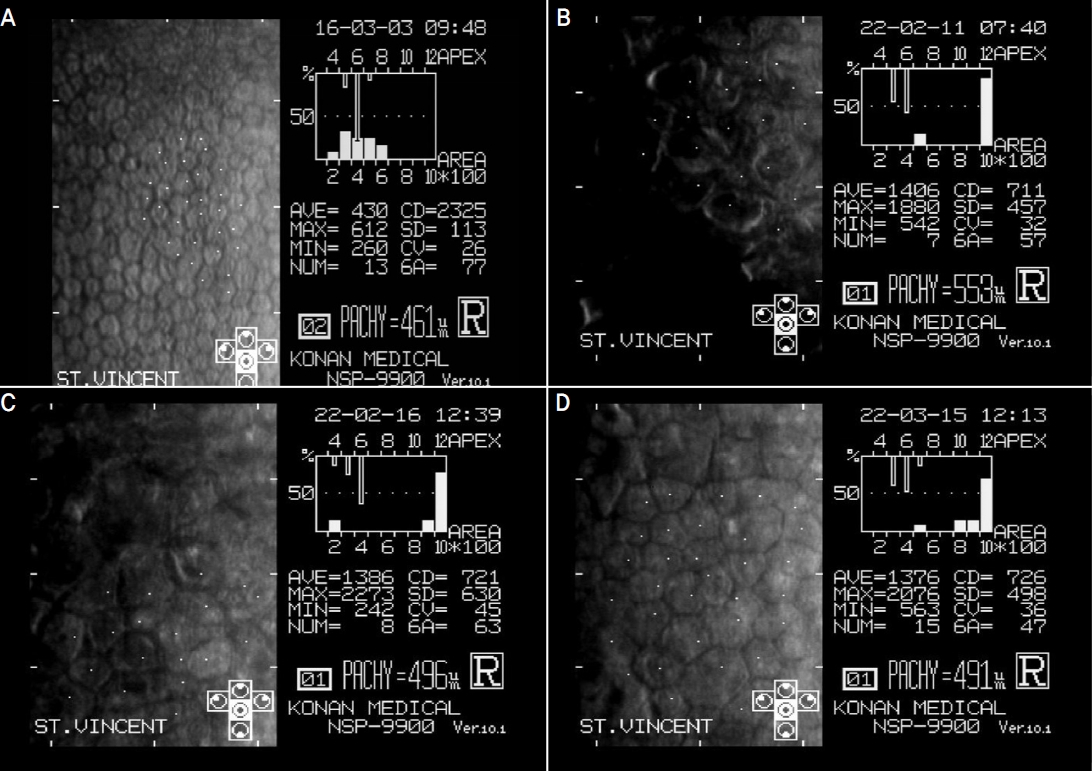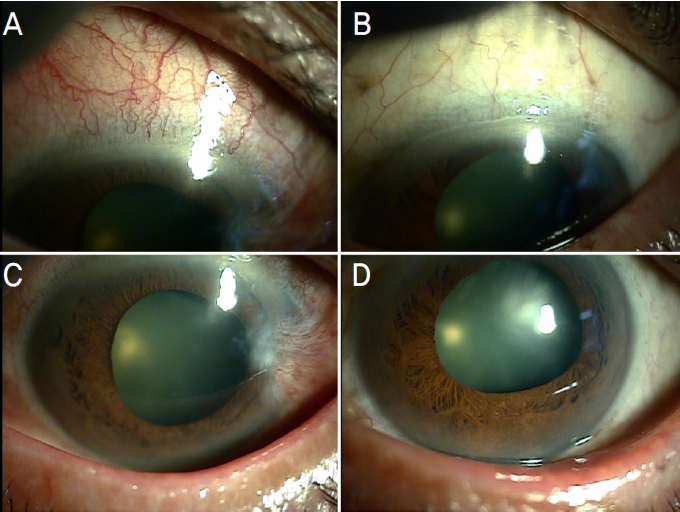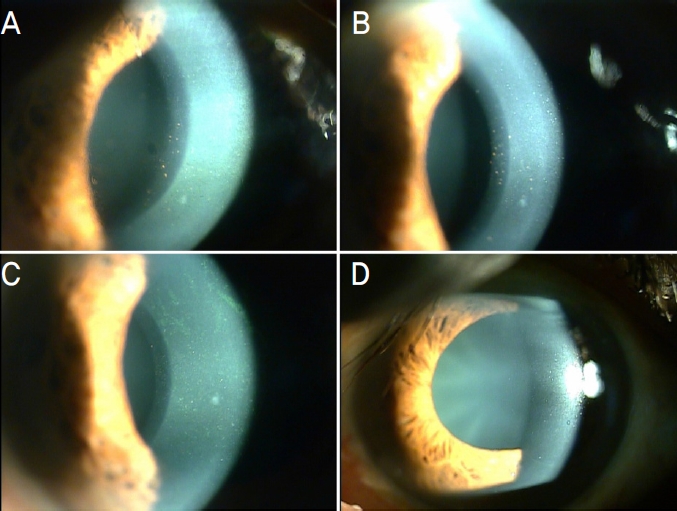 |
 |
| J Korean Ophthalmol Soc > Volume 64(8); 2023 > Article |
|
ĻĄŁļ¼Ėņ┤łļĪØ
ļ¬®ņĀü
ņĮöļĪ£ļéśļ░öņØ┤ļ¤¼ņŖż ĒÅÉļĀ┤ņŚÉ ņåŹļ░£ĒĢ£ Ļ│ĀņĢłņĢĢņä▒ ņĢ×ĒżļÅäļ¦ēņŚ╝ ļ░Å Ļ░üļ¦ēļé┤Ēö╝ņŚ╝ņØä ņ¦äļŗ©ĒĢśņŚ¼ ļ│┤Ļ│ĀĒĢśĻ│Āņ×É ĒĢ£ļŗż.
ņ”ØļĪĆņÜöņĢĮ
71ņäĖ ļé©ĒÖśņØ┤ 10ņØ╝ ņĀä COVID-19 ĒÖĢņ¦ä ļÆż 2ņØ╝ ĒøäļČĆĒä░ ņÜ░ņĢł ņŗ£ļĀźņĀĆĒĢś, ĒåĄņ”Ø, ļłłĻ║╝ĒÆĆ ļČĆņóģ ļ░Å ļæÉĒåĄņØä ņŻ╝ņåīļĪ£ ļé┤ņøÉĒĢśņśĆļŗż. ļé┤ņøÉ ņŗ£ ļéśņĢłņŗ£ļĀź ņÜ░ņĢł 0.04, ņóīņĢł 0.15, ļ¬©ļæÉ ĻĄÉņĀĢļČłĻ░ĆĒĢśņśĆļŗż. ņĀäņĢłļČĆĻ▓Ćņé¼ņāü ņÜ░ņĢł Ļ▓░ļ¦ēņČ®Ēśł, ņāüņĖĪņØś Ļ░üļ¦ēļČĆņóģņŚÉ ļÅÖļ░śļÉ£ ļŹ░ņŖżļ®öļ¦ē ņĀæĒל, ņāēņåīņä▒ Ļ░üļ¦ēĒøäļ®┤ņ╣©ņ░®ļ¼╝, ņĀäļ░®ņŚ╝ņ”ØņØ┤ ĒÖĢņØĖļÉśņŚłļŗż. ņ¢æņĢł ļÅÖĻ│ĄņØĆ ņé░ļīĆļÉśņŚłņ£╝ļ®░, ļīĆĻ┤æļ░śņé¼ļŖö ņĀĆĒĢśļÉśņŚłļŗż. ņÜ░ņĢł Ļ░üļ¦ēļé┤Ēö╝ņäĖĒżĻ▓Ćņé¼ņāü ņäĖĒż ļ░ĆļÅä 711 cells/mm2ļĪ£ Ļ░ÉņåīĒĢ┤ ņ׳ņŚłĻ│Ā, ņĀäļ░śņĀüņ£╝ļĪ£ ņäĖĒżļōżņØś Ēü¼ĻĖ░Ļ░Ć ņ”ØĻ░ĆĒĢśņśĆĻ│Ā, ņ¢┤ļæÉņÜ┤ ņØīņśüņØś ĒĢĄņØä Ļ░Ćņ¦ä ņäĖĒżļōżņØ┤ Ļ┤Ćņ░░ļÉśņŚłļŗż. ņČöņĀü Ļ┤Ćņ░░ ņżæ ņÜ░ņĢł ņĢłņĢĢņāüņŖ╣ņØ┤ ļ│┤ņŚ¼ ņØ┤ņŚÉ ņÜ░ņĢł Ļ│ĀņĢłņĢĢņä▒ ņĢ×ĒżļÅäļ¦ēņŚ╝ ļ░Å Ļ░üļ¦ēļé┤Ēö╝ņŚ╝ ņ¦äļŗ©ĒĢś ņŗ£Ē¢ēĒĢ£ Ļ▒░ļīĆņäĖĒżļ░öņØ┤ļ¤¼ņŖżĻ▓Ćņé¼ņŚÉņä£ ņØīņä▒ņØ┤ ĒÖĢņØĖļÉśņŚłļŗż. ņĢĮ 2ņŻ╝ņØś ņŖżĒģīļĪ£ņØ┤ļō£ ņĢłņĢĮ ļ░Å ņĢłņĢĢĒĢśĻ░ĢņĀ£ ņĀÉņĢł ņ╣śļŻī Ēøä ĒśĖņĀäļÉśņŚłļŗż.
ABSTRACT
Purpose
We report a patient diagnosed with COVID-19-associated hypertensive anterior uveitis and endotheliitis of the cornea.
Case Summary
A 71-year-old male visited our hospital with decreased visual acuity, ocular pain, eyelid swelling of in his right eye, and headache for 8 days. He had been diagnosed with COVID-19 pneumonia 10 days before the visit. The best-corrected visual acuity was 0.04 in his right eye and 0.15 in his left eye. Severe conjunctival injection, moderate corneal edema with Descemet membrane folding, diffuse keratic precipitates and mild anterior chamber reaction were observed in the right eye, which were not present in the previous examination. Pupils in both eyes were moderately dilated and slow to react in response to direct light. The density of endothelial cells in the right eye was 711 cells/mm2 and an owlŌĆÖs eye morphology of endothelial cells was observed via specular microscopy. During follow up, elevated intraocular pressure (IOP) in the right eye was noted. Polymerase chain reaction (PCR) examination of the aqueous humor for cytomegalovirus was negative. After 2 weeks of applying prednisolone eye drops and anti-glaucoma eye drops, corneal edema decreased, and his vision improved to 0.5. However, the density of the corneal endothelium remained low.
2019ļģäņŚÉ ļ░£ņāØĒĢśņŚ¼, Ēśäņ×¼Ļ╣īņ¦ĆļÅä ņżæļīĆĒĢ£ ĒīīņןņØä ļČłļ¤¼ņśżĻ│Ā ņ׳ļŖö Severe Acute Respiratory Syndrome-Coronavirus-2 (SARSCoV-2)ļŖö ļåÆņØĆ Ļ░ÉņŚ╝ļźĀ(infectivity)ņØä ļ│┤ņØ┤ļ®░, ĒśĖĒØĪĻĖ░ ņÖĖņŚÉļÅä ņŗĀĻ▓ĮĻ│ä ņ¦łĒÖś, ņŗ¼ĒśłĻ┤ĆĻ│ä ņ¦łĒÖś, ĒśłņĢĪĒĢÖņĀü ņØ┤ņāü, ņåīĒÖöĻĖ░ ļ░Å ļé┤ļČäļ╣äĻ│äņŚÉ Ļ▒Ėņ│Éņä£ ņ¦üņĀæ ļśÉļŖö Ļ░äņĀæņĀüņ£╝ļĪ£ ĒĢ®ļ│æņ”ØņØä ņĢ╝ĻĖ░ĒĢ£ļŗżĻ│Ā ļ│┤Ļ│ĀļÉśņŚłļŗż.1
SARS-CoV-2ļŖö ņĢłņ¦ĆņśżĒģÉņŗĀņĀäĒÖśĒÜ©ņåī-2 (angiotensin converting enzyme-2, ACE-2) ņłśņÜ®ņ▓┤ļź╝ ņØ┤ņÜ®ĒĢśņŚ¼ ņØĖĻ░äņäĖĒżņŚÉ ņ╣©Ēł¼ĒĢ£ļŗżĻ│Ā ņĢīļĀżņĀĖ ņ׳ņ£╝ļ®░, ņØ┤ ņłśņÜ®ņ▓┤Ļ░Ć ĒÆŹļČĆĒĢśĻ▓ī ļ░£ĒśäļÉśņ¢┤ ņ׳ļŖö ĒśłĻ┤Ćļé┤Ēö╝ņäĖĒżņŚÉ ņ╣©Ēł¼ĒĢśņŚ¼, ļé┤Ēö╝ņäĖĒżņØś ņŚ╝ņ”Ø ļ░Å ĻĖ░ļŖźļČĆņĀä(endothelial dysfunction)ņØä ņ£Āļ░£ĒĢśļŖö Ļ▓āņØ┤ COVID-19 Ļ░ÉņŚ╝ņ”ØņØś ņŻ╝ņÜö ļ│æņØĖņ£╝ļĪ£ ņĢīļĀżņĀĖ ņ׳ļŗż.1
SARS-CoV-2 ļ░öņØ┤ļ¤¼ņŖżņÖĆ Ļ┤ĆļĀ©ļÉ£ ĒØöĒĢ£ ņĢłĻĄ¼ ĒĢ®ļ│æņ”Øņ£╝ļĪ£ļŖö 7.6%ņŚÉņä£ Ļ▓░ļ¦ēņČ®ĒśłņØ┤ ļÅÖļ░śļÉśņŚłļŗżĻ│Ā ĒĢśļ®░, COVID-19 ņ”ØņāüņØ┤ ņŗ¼ĒĢĀņłśļĪØ ņĢłĻĄ¼ ĒĢ®ļ│æņ”Ø Ļ░ĆļŖźņä▒ņØ┤ ļåÆļŗżĻ│Ā ņĢīļĀżņĀĖ ņ׳ļŗż.2 ņØ┤ļ¤¼ĒĢ£ ņĢłĻ│╝ņĀü ĒĢ®ļ│æņ”ØņØĆ ņé¼ļ×īņØś Ļ░üļ¦ē ļ░Å Ļ▓░ļ¦ēņŚÉ ļåÆĻ▓ī ļ░£ĒśäļÉśņ¢┤ ņ׳ļŖö ACE-2 ņłśņÜ®ņ▓┤ļĪ£ ņäżļ¬ģĒĢĀ ņłś ņ׳ļŗż.3 ņŗżņĀ£ļĪ£ ĒÖśņ×ÉņØś Ļ▓░ļ¦ē swabņØä ņŗ£Ē¢ēĒĢśņśĆņØä ļĢī, ĒÖśņ×ÉņØś 3.9%ņŚÉņä£ SARSCoV-2 ļ░öņØ┤ļ¤¼ņŖż ņ¢æņä▒ ņåīĻ▓¼ņØä ļ│┤ņśĆņ£╝ļ®░,2 ļ¼┤ņ”Øņāü COVID-19 ĒÖśņ×ÉņØś ļłłļ¼╝ ļ░Å ļ░®ņłś, ņ£Āļ”¼ņ▓┤ņŚÉņä£ļÅä ļ░öņØ┤ļ¤¼ņŖżĻ░Ć Ļ▓ĆņČ£ļÉśņŚłļŗżĻ│Ā ļ│┤Ļ│ĀļÉ£ ļ░ö ņ׳ļŗż.4
ļ│Ė ņ”ØļĪĆņŚÉņä£ļŖö COVID-19 ĒÅÉļĀ┤ ĒÖśņ×ÉņŚÉņä£ ļ░£ņāØĒĢ£ ļŗ©ņĢłņä▒ Ļ░üļ¦ēļé┤Ēö╝ņŚ╝ ļ░Å Ļ│ĀņĢłņĢĢņä▒ ņĢ×ĒżļÅäļ¦ēņŚ╝ņØä Ļ▓ĮĒŚśĒĢśņŚ¼ ņØ┤ļź╝ ĻĄŁļé┤ņŚÉ ņĄ£ņ┤łļĪ£ ļ│┤Ļ│ĀĒĢśĻ│Āņ×É ĒĢ£ļŗż.
71ņäĖ ļé©ņ×É ĒÖśņ×ÉļĪ£ ļé┤ņøÉ 10ņØ╝ ņĀä SARS-CoV-2 ļ░öņØ┤ļ¤¼ņŖż Ļ░ÉņŚ╝ ĒÖĢņ¦äļ░øņØĆ Ēøä COVID-19 ĒÅÉļĀ┤ņ£╝ļĪ£ ņ×ģņøÉ ņ╣śļŻī ņżæ, ĒÖĢņ¦äļÉ£ 2ņØ╝ ĒøäļČĆĒä░ ņ¦ĆņåŹļÉ£ ņÜ░ņĖĪ ņŗ£ļĀźņĀĆĒĢś, ļłłĒåĄņ”Ø, ļłłĻ║╝ĒÆĆ ļČĆņóģ ļ░Å ļæÉĒåĄņØä ņŻ╝ņåīļĪ£ ļé┤ņøÉĒĢśņśĆļŗż. Ļ│╝Ļ▒░ļĀźņāü ļŗ╣ļć© ļ░Å Ļ│ĀĒśłņĢĢņ£╝ļĪ£ ņĢĮļ¼╝ ļ│ĄņÜ® ņżæņØ┤ņŚłņ£╝ļ®░, 6ļģä ņĀä ņóīņĢł ĒżļÅäļ¦ēņŚ╝ņä▒ ļģ╣ļé┤ņן ņ¦äļŗ©ĒĢś 2% dorzolamide/0.5% timolol (Cosopt┬«, Santen Pharmaceutical Co.,Ltd., Seoul, Korea), 0.15% brimonidine tartrate (Alphagan┬«, Allergan Korea Ltd., Seoul, Korea)ļź╝ ņĀÉņĢłĒĢśļŗżĻ░Ć Ļ▓ĮĻ│╝ Ļ┤Ćņ░░ņØ┤ ņżæļŗ©ļÉśņŚłļŹś ĻĖ░ņÖĢļĀźņØ┤ ņ׳ņŚłļŗż. 2016ļģä ļ¦łņ¦Ćļ¦ē ņ¦äļŻī ļŗ╣ņŗ£ ņÜ░ņĢł ļéśņĢłņŗ£ļĀź 1.0, ņóīņĢł ļéśņĢłņŗ£ļĀź 0.8ņØ┤ņŚłņ£╝ļ®░, ņĀäļ░®ņØś ņŚ╝ņ”ØņØĆ ņŚåņŚłĻ│Ā, Ļ░üļ¦ēļé┤Ēö╝ņäĖĒżļ░ĆļÅäļŖö ņÜ░ņĢł 2,324 cells/mm2 , ņóīņĢł 2,544 cells/mm2ļĪ£ ĒŖ╣ņØ┤ ņåīĻ▓¼ņØĆ ņŚåņŚłļŗż(Fig. 1A).
ļé┤ņøÉ ņŗ£ ņĢłĻ│╝Ļ▓Ćņé¼ņāü ļéśņĢłņŗ£ļĀźņØĆ ņÜ░ņĢł 0.04, ņóīņĢł 0.15ņśĆĻ│Ā ņ¢æņĢł ļ¬©ļæÉ ĻĄÉņĀĢļÉśņ¦Ć ņĢŖņĢśņ£╝ļ®░, ļ╣äņĀæņ┤ēņä▒ ņĢłņĢĢĻ│äĻ▓Ćņé¼ņŚÉņä£ ņÜ░ņĢł 16.2 mmHg, ņóīņĢł 19.2 mmHgļĪ£ ņĖĪņĀĢļÉśņŚłļŗż.
ņÜ░ņĖĪ ņĢłĻ▓ĆņØś Ļ▓ĮĒĢ£ ļČĆņóģĻ│╝ ĒĢ©Ļ╗ś ņäĖĻĘ╣ļō▒Ēśäļ»ĖĻ▓ĮĻ▓Ćņé¼ņāü ņóīņĢłņŚÉ ļ╣äĒĢśņŚ¼ ņÜ░ņĢł Ļ▓░ļ¦ēņØ┤ ņŗ¼ĒĢśĻ▓ī ņČ®ĒśłļÉśņ¢┤ ņ׳ņŚłņ£╝ļ®░(Fig. 2A, B), ņāüņĖĪņØś Ļ░üļ¦ēļČĆņóģĻ│╝ ņØ┤ņŚÉ ļÅÖļ░śļÉ£ ļŹ░ņŖżļ®öļ¦ē ņĀæĒלņØ┤ ĒÖĢņØĖļÉśņŚłļŗż(Fig. 3A). Ļ░üļ¦ēĒøäļ®┤ņ╣©ņ░®ļ¼╝ņØ┤ Ļ░üļ¦ēļé┤Ēö╝ ņĀäļ░śņŚÉ Ļ▒Ėņ│É Ļ┤Ćņ░░ļÉśņŚłņ£╝ļ®░, ņĀäļ░®ņŚ╝ņ”ØņäĖĒż 1+ļĪ£ Ļ▓ĮĒĢ£ ņŚ╝ņ”ØņØä ļ│┤ņśĆļŗż. ņ¢æņĢłņØś ļÅÖĻ│ĄņØĆ ņżæļō▒ļÅäļĪ£ ņé░ļÅÖļÉśņ¢┤ ņ׳ņŚłņ£╝ļ®░ ļÅÖĻ│Ąļ░śņé¼ļŖö Ļ┤Ćņ░░ļÉśņ¦Ć ņĢŖņĢśļŗż(Fig 2C, D). ņĢłņĀĆĻ▓Ćņé¼ņāü Ļ░üļ¦ēļČĆņóģņ£╝ļĪ£ ņØĖĒĢśņŚ¼ ĒØÉļ”¼Ļ▓ī ļ│┤ņśĆņ£╝ļéś, ņĀĆļ¬ģĒĢ£ ņŚ╝ņ”Ø ņåīĻ▓¼ņØĆ Ļ┤Ćņ░░ļÉśņ¦Ć ņĢŖņĢśļŗż. ņØ┤ņŚÉ ņÜ░ņĢł ņĢ×ĒżļÅäļ¦ēņŚ╝ ļ░Å Ļ░üļ¦ēļé┤Ēö╝ņäĖĒżņŚ╝ ņ¦äļŗ©ĒĢś ņÜ░ņĢł 0.5% levofloxacin hydrate (Cravit┬«, Santen Pharmaceutical Korea Co., Ltd., Seoul, Korea) 4ĒÜī, 1% prednisolone acetate (Predbell┬«, Chong Kun Dang Pharmaceutical, Seoul, Korea) 2ņŗ£Ļ░ä Ļ░äĻ▓®, Cosopt┬« 2ĒÜī ņĀÉņĢłĒĢśļÅäļĪØ ĒĢśņśĆļŗż.
2ņØ╝ Ēøä ņŗ£Ē¢ēĒĢ£ Ļ▓Ćņé¼ņāü ņŗ£ļĀźņØĆ Ļ│äņåŹ ņĀĆĒĢśļÉ£ ņāüĒā£ņśĆņ£╝ļ®░, ļ╣äņĀæņ┤ēņä▒ ņĢłņĢĢĻ│äĻ▓Ćņé¼ņŚÉņä£ ņÜ░ņĢłņØś ņĢłņĢĢņØĆ 16 mmHgļĪ£ ņĖĪņĀĢļÉśņŚłļŗż. ņĀäņĢłļČĆĻ▓Ćņé¼ņāü ņÜ░ņĢłņØś Ļ░üļ¦ēĒøäļ®┤ņ╣©ņ░®ļ¼╝ņØ┤ ņ¦ĆņåŹņĀüņ£╝ļĪ£ Ļ┤Ćņ░░ļÉśņŚłĻ│Ā(Fig. 3B), Ļ░üļ¦ē Ļ▓Įļ®┤Ēśäļ»ĖĻ▓ĮĻ▓Ćņé¼ņāü ņÜ░ņĢł Ļ░üļ¦ēļé┤Ēö╝ņäĖĒżļ░ĆļÅäĻ░Ć 711 cells/mm2ļĪ£ 6ļģäņĀä ļ¦łņ¦Ćļ¦ē Ļ▓Ćņé¼ņŚÉ ļ╣äĒĢśņŚ¼ ĒśäņĀĆĒ׳ Ļ░ÉņåīļÉśĻ│Ā Ļ░üļ¦ēļæÉĻ╗śĻ░Ć ņ”ØĻ░ĆĒĢśņśĆņ£╝ļ®░(Fig. 1B), ņ¢┤ļæÉņÜ┤ ņØīņśüņØś ĒĢĄņØä Ļ░Ćņ¦ä ņäĖĒż ļ░Å ņĀäļ░śņĀüņ£╝ļĪ£ ņäĖĒżņØś Ēü¼ĻĖ░Ļ░Ć ņ╗żņ¦ä ņåīĻ▓¼ņØ┤ Ļ┤Ćņ░░ļÉśņŚłļŗż(Fig. 1B). ņóīņĢł Ļ░üļ¦ēļé┤Ēö╝ņäĖĒżĻ▓Ćņé¼ Ļ▓░Ļ│╝ ņłśņÖĆ ļ¬©ņ¢æņØ┤ ņĀĢņāü ļ▓öņ£äņŚÉ ņåŹĒĢśņśĆļŗż.
5ņØ╝ Ēøä ņČöņĀü Ļ┤Ćņ░░ ņŗ£ ņÜ░ņĢł ļéśņĢłņŗ£ļĀź 0.3ņ£╝ļĪ£ ĒśĖņĀäļÉśņŚłņ£╝ļéś ĻĄÉņĀĢļÉśņ¦Ć ņĢŖņĢśņ£╝ļ®░, ņÜ░ņĢł ņĢłņĢĢņØĆ 28 mmHgĻ╣īņ¦Ć ņāüņŖ╣ĒĢśņśĆļŗż. Ļ░üļ¦ē Ļ▓Įļ®┤Ēśäļ»ĖĻ▓ĮĻ▓Ćņé¼ņāü ņ¢┤ļæÉņÜ┤ ņØīņśüņØś ĒĢĄņØä Ļ░Ćņ¦ä ņäĖĒżĻ░Ć ņĪ░ĻĖł ļŹö ņżäņ¢┤ļō£ļŖö ņåīĻ▓¼ņØä ļ│┤ņśĆĻ│Ā Ļ░üļ¦ēļæÉĻ╗śļÅä ļ│┤ļŗż Ļ░ÉņåīĒĢśņśĆļŗż(Fig. 1C). ņĢłņĀĆĻ▓Ćņé¼ņāü ļÆżĒżļÅäļ¦ēņŚ╝ ņåīĻ▓¼ņØĆ Ļ┤Ćņ░░ļÉśņ¦Ć ņĢŖņĢśļŗż(Fig. 4). ņØ┤ņŚÉ ņÜ░ņĢł Ļ░üļ¦ēļé┤Ēö╝ņŚ╝(endotheliitis of cornea) ļ░Å Ļ│ĀņĢłņĢĢņä▒ ņĢ×ĒżļÅäļ¦ēņŚ╝(hypertensive anterior uveitis)ņ£╝ļĪ£ ņ¦äļŗ©ĒĢś, ņøÉņØĖ Ļ░Éļ│äņØä ņ£äĒĢśņŚ¼ ņĀäļ░®ņ▓£ņ×Éļź╝ ņŗ£Ē¢ēĒĢśņŚ¼ ļ░®ņłśļź╝ ņ▒äņĘ©ĒĢ£ Ēøä Ļ▒░ļīĆņäĖĒżļ░öņØ┤ļ¤¼ņŖż(cytomegalovirus)ņŚÉ ļīĆĒĢ£ polymerase chain reaction (PCR) Ļ▓Ćņé¼ļź╝ ņŗ£Ē¢ēĒĢśņśĆņ£╝ļ®░, Ļ▓░Ļ│╝ļŖö ņØīņä▒ņ£╝ļĪ£ ĒÖĢņØĖļÉśņŚłļŗż. ņĢłņĢĢ ņĪ░ņĀłņØä ņ£äĒĢśņŚ¼ Alphagan┬«(Allergan Korea Ltd.) ļ░Å 0.005% latanoprost (Xalatan┬«, Viatris Korea, Seoul, Korea)ļź╝ ņČöĻ░ĆĒĢśņśĆļŗż.
1ļŗ¼ Ēøä ņÜ░ņĢł ļéśņĢłņŗ£ļĀźņØĆ 0.5Ļ╣īņ¦Ć ĒÜīļ│ĄļÉśņŚłņ£╝ļ®░, ļŹ░ņŖżļ®öļ¦ē ņĀæĒל ļ░Å Ļ░üļ¦ēĒøäļ®┤ņ╣©ņ░®ļ¼╝ņØ┤ ņĀÉņ░© ĒśĖņĀäļÉśņŚłļŗż(Fig. 3C). Cosopt┬« (Santen Pharmaceutical Korea Co., Ltd) ļ░Å Alphagan┬« (Allergan Korea Ltd.)ņØä ņé¼ņÜ®ĒĢśļ®░ ņĢłņĢĢņØĆ 21 mmHgļĪ£ ņ£Āņ¦ĆļÉśņŚłĻ│Ā, Ļ░üļ¦ēļé┤Ēö╝ņäĖĒżļ░ĆļÅäļŖö 726 cells/mm2ļĪ£ ņŚ¼ņĀäĒ׳ Ļ░ÉņåīļÉśņ¢┤ ņ׳ņŚłņ£╝ļéś, ņ¢┤ļæÉņÜ┤ ņØīņśüņØś ĒĢĄņØä Ļ░Ćņ¦ä ņäĖĒżĻ░Ć Ļ▒░ņØś ņŚåņ¢┤ņ¦ĆĻ│Ā, Ļ░üļ¦ēļé┤Ēö╝ņäĖĒżņØś Ļ▓ĮĻ│äĻ░Ć ļ¬ģĒÖĢĒĢ┤ņ¦ĆļŖö ņ¢æņāüņØä ļ│┤ņśĆļŗż(Fig. 1D). ņØ┤ņŚÉ Predbell┬« (Chong Kun Dang Pharmaceutical) ņĀÉņĢł Ēܤņłśļź╝ 2ņŗ£Ļ░ä Ļ░äĻ▓®, 4ĒÜī, 2ĒÜī, 1ĒÜīļĪ£ 2.5Ļ░£ņøöņŚÉ Ļ▒Ėņ│É Ļ░Éļ¤ēĒĢśņśĆļŗż. 4Ļ░£ņøö Ēøä ļŗżņŗ£ ļé┤ņøÉĒĢśņśĆņØä ļĢī ņÜ░ņĢł Ļ░üļ¦ēņØś Ēł¼ļ¬ģņä▒ņØ┤ ĒÜīļ│ĄļÉśĻ│Ā ņĢ×ĒżļÅäļ¦ēņŚ╝ ļ░Å Ļ░üļ¦ēļé┤Ēö╝ņŚ╝ņØ┤ ņ×¼ļ░£ĒĢśņ¦Ć ņĢŖņØīņØä ĒÖĢņØĖĒĢśņśĆļŗż(Fig. 3D). ĻĘĖļ¤¼ļéś ņ¢æņĢłņØś ņżæļō▒ļÅäļĪ£ ņé░ļÅÖļÉ£ ļÅÖĻ│ĄņØĆ ĻĘĖļīĆļĪ£ ņ£Āņ¦ĆļÉśĻ│Ā ņ׳ļŖö ņåīĻ▓¼ņØä ļ│┤ņśĆļŗż.
SARS-CoV-2ļ░öņØ┤ļ¤¼ņŖżņØś ņäĖĒżĒæ£ļ®┤ņØś ņłśņÜ®ņ▓┤ ņżæ ĒĢśļéśņØĖ ACE2ļŖö ņĀĢņāüņĀüņ£╝ļĪ£ ĒÅÉ ņĀÉļ¦ē, ņåīĒÖöĻĖ░ ļ░Å Ļ▓░ļ¦ē ļō▒ņŚÉ ņĪ┤ņ×¼ĒĢ£ļŗżĻ│Ā ņĢīļĀżņĪīļŗż.1 ĒŖ╣Ē׳ ņé¼ļ×ī Ļ░üļ¦ēņāüĒö╝ ļ░Å Ļ▓░ļ¦ēņāüĒö╝ņŚÉļŖö ļ░öņØ┤ļ¤¼ņŖżņØś ņ╣©Ēł¼ ļ¦żĻ░£ņ▓┤Ļ░Ć ļÉśļŖö ACE2ņØś ĒÖ£ņä▒ņØ┤ ļåÆņĢä ņ┤łĻĖ░ Ļ░ÉņŚ╝ Ļ▓ĮļĪ£ļĪ£ņä£ ļ░öņØ┤ļ¤¼ņŖżĻ░Ć Ļ░üļ¦ēĒæ£ļ®┤ņØä ĒåĄĒĢ┤ ņ╣©Ēł¼ĒĢĀ Ļ░ĆļŖźņä▒ļÅä ņĀ£ĻĖ░ļÉśņŚłļŗż.3
Zhou et al3ņØĆ ņĀĢņāü ņĢłĻĄ¼ņŚÉņä£ ļ░öņØ┤ļ¤¼ņŖżņØś ņäĖĒż ņłśņÜ®ņ▓┤ņØĖ ACE2 ļ░Å ļ░öņØ┤ļ¤¼ņŖżņÖĆ ACE2ņØś Ļ▓░ĒĢ®ņØä ļÅĢļŖö ĒÜ©ņåīņØĖ transmembrane protease serine subtype 2ņØś ļČäĒżļź╝ ņŚ░ĻĄ¼ĒĢśņśĆņØä ļĢī ļæÉ ļŗ©ļ░▒ņ¦ł ļ¬©ļæÉ Ļ░üļ¦ēņāüĒö╝ņäĖĒżņÖĆ ļÅÖņØ╝ĒĢ£ Ļ░ĢļÅäļĪ£ Ļ░üļ¦ēļé┤Ēö╝ņäĖĒżņŚÉņä£ļÅä ļ░£ĒśäļÉ©ņØä ļ│┤Ļ│ĀĒĢśņśĆļŗż. Sawant et al5ņØĆ COVID-19 ĒÖśņ×ÉņØś ņé¼Ēøä ņĢłĻĄ¼ņŚÉņä£ SARS-CoV-2ņŚÉ ļīĆĒĢ£ PCR Ļ▓Ćņé¼ļź╝ ņŗ£Ē¢ēĒĢśņśĆņØä ļĢī, ļ░öņØ┤ļ¤¼ņŖż RNAĻ░Ć Ļ░Ćņן ĒØöĒ׳ ļ░£Ļ▓¼ļÉśļŖö ņĪ░ņ¦üņØĆ Ļ░üļ¦ēĒøäļ®┤ņØ┤ļØ╝Ļ│Ā ļ│┤Ļ│ĀĒĢśņśĆļŗż. ļśÉĒĢ£ COVID-19ņØś ĻĖ░ņÖĢļĀźņØ┤ ņ׳ļŹś ĒÖśņ×ÉņØś Ļ▓░ļ¦ē ļ░Å ņä¼ņ£ĀņŻ╝ņäĖĒż, ĒÖŹņ▒äņŚÉņä£ SARS-CoV-2ļŗ©ļ░▒ņ¦łņØ┤ ļ░£Ļ▓¼ļÉśņŚłļŗż.6
ņŗżņĀ£ļĪ£ COVID-19 ĒÖśņ×ÉļōżņŚÉņä£ Ļ░üļ¦ēļé┤Ēö╝ņäĖĒżļź╝ Ļ┤Ćņ░░ĒĢśņśĆņØä ļĢī, ņĀĢņāüņØĖņŚÉ ļ╣äĒĢśņŚ¼ ņäĖĒż ņłś ļ░Å ņ£ĪĻ░üĒśĢ ņäĖĒżņØś ļ╣äņ£©ņØ┤ ļ¢©ņ¢┤ņĀĖ ņ׳ņŚłļŗż.7 ņŗżņĀ£ ļ¼┤ņ”ØņāüņØś ĒÖśņ×ÉņØś ļ░▒ļé┤ņןņłśņłĀ ņŗ£ ņłśņ¦æĒĢ£ ņĀäļ░® ļ░®ņłśņŚÉņä£ SARS-CoV-2ņŚÉ ļīĆĒĢ£ PCR Ļ▓Ćņé¼ļź╝ ņŗ£Ē¢ēĒĢśņśĆņØä ļĢī ņĢĮ 19%ņŚÉņä£ ļ░öņØ┤ļ¤¼ņŖżĻ░Ć Ļ▓ĆņČ£ļÉśņŚłļŗż.4 ņØ┤ļ¤¼ĒĢ£ Ļ▓░Ļ│╝ļŖö ļ░öņØ┤ļ¤¼ņŖżĻ░Ć ĒśłĒ¢ēņä▒ņ£╝ļĪ£ ĒśłņĢĪ-ļ░®ņłś ņןļ▓ĮņØä ĒåĄĻ│╝ĒĢśņŚ¼ ņĀäļ░®ņŚÉ ņ£Āņ×ģļÉ£ Ēøä ļ®┤ņŚŁĒŖ╣ĻČī ņ¦ĆņŚŁņØĖ ņĀäļ░®ņŚÉņä£ ļ®┤ņŚŁļ░śņØæņ£╝ļĪ£ļČĆĒä░ ļ│┤ĒśĖļÉ©ņ£╝ļĪ£ņŹ©, ņåīļ®ĖļÉśņ¦Ć ņĢŖĻ│Ā ņ¦ĆņåŹņĀüņ£╝ļĪ£ ņĪ┤ņ×¼ĒĢĀ Ļ░ĆļŖźņä▒ņØä ņŗ£ņé¼ĒĢ£ļŗż.
SARS-CoV-2ļŖö ļé┤Ēö╝ņäĖĒżņŚÉ ņ╣©Ēł¼ĒĢśņŚ¼ ļé┤Ēö╝ņäĖĒżņØś ņןļ▓Į ĻĖ░ļŖźņØä ņåīņŗżņŗ£ņ╝£, ļé┤Ēö╝ņäĖĒżņØś ņŚ╝ņ”Ø ļ░Å ĻĘĖļĪ£ ņØĖĒĢ£ ļ¦īņä▒ņĀü ļé┤Ēö╝ņäĖĒż ĻĖ░ļŖźļČĆņĀäņØä ņ£Āļ░£ĒĢśļ®░ ņØ┤ļŖö COVID-19ņØś ņŻ╝ņÜö ļ│æņØĖņ£╝ļĪ£ ņĢīļĀżņĀĖ ņ׳ļŗż.1 ļ│Ė ņ”ØļĪĆļŖö Ļ░üļ¦ēļé┤Ēö╝ņäĖĒżņØś ņŚ╝ņ”Ø ļ░Å Ļ▓ĮĒĢ£ ņŚ╝ņ”Ø ļ░Å Ļ│ĀņĢłņĢĢņØä ļ│┤ņśĆļŗż. ņä¼ņ£ĀņŻ╝ņäĖĒżļŖö ņŗĀĻ▓ĮļŖź(neural crest)ņŚÉņä£ ņ£ĀļלĒĢśņśĆņ£╝ļ®░, ļŗżņ¢æĒĢ£ ņäĖĒżņØś ĒŖ╣ņ¦Ģ ņżæ ļé┤Ēö╝ņäĖĒżņØś ĒŖ╣ņ¦ĢņØä ļ│┤ņ£ĀĒĢśĻ│Ā ņ׳ļŗż. ļö░ļØ╝ņä£ ļ░®ņłśņŚÉ ņ╣©ņ×ģĒĢ£ ļ░öņØ┤ļ¤¼ņŖżĻ░Ć Ļ░üļ¦ēļé┤Ēö╝ņäĖĒż ļ░Å ņä¼ņ£ĀņŻ╝ņäĖĒżņŚÉ Ļ░ÉņŚ╝ļÉ©ņ£╝ļĪ£ņŹ© ļ®┤ņŚŁ ņĪ░ņĀł ņןņĢĀ ļ░Å ņŚ╝ņ”Øļ░śņØæņØä ņ£Āļ░£ĒĢśņŚ¼, Ļ░üļ¦ē ĻĖ░ļŖźļČĆņĀä ļ░Å Ļ│ĀņĢłņĢĢņØä ņ£Āļ░£ĒĢśņśĆņØä Ļ░ĆļŖźņä▒ņØ┤ ņ׳ļŗż.
Ļ▒░ļīĆņäĖĒżļ░öņØ┤ļ¤¼ņŖżļŖö Ļ░üļ¦ēļé┤Ēö╝ņäĖĒżņŚ╝ņØä ļÅÖļ░śĒĢśĻ│Ā ĒÖŹņ▒äļź╝ ņ╣©ļ▓öĒĢśļŖö ņĢ×ĒżļÅäļ¦ēņŚ╝ņØś Ļ▓ĮņÜ░ Ļ░Ćņן ĒØöĒĢ£ ņøÉņØĖņ£╝ļĪ£ ņĢīļĀżņĀĖ ņ׳ļŗż.8 Mazzotta and Giancipoli9ļŖö COVID-19 ĒÖśņ×ÉņŚÉņä£ ĻĖ░ņĪ┤ ĒżļÅäļ¦ēņŚ╝ņØś ņ×¼ļ░£ņØä ļ│┤Ļ│ĀĒĢ£ ļ░ö ņ׳ļŗż. ļśÉĒĢ£ ĒŚżļź┤ĒÄśņŖżļ░öņØ┤ļ¤¼ņŖżĻ│╝ņØś ļ░öņØ┤ļ¤¼ņŖż Ļ░ÉņŚ╝Ļ│╝ Ļ┤ĆļĀ©ļÉ£ Ļ░üļ¦ēļé┤Ēö╝ņäĖĒżņŚ╝ņØĆ ņŻ╝ļĪ£ ļŗ©ņĢłņä▒ņ£╝ļĪ£ ļ░£ņāØĒĢ£ļŗżĻ│Ā ņĢīļĀżņĀĖ ņ׳ļŗż.8 ļö░ļØ╝ņä£ ļ│Ė ņĀĆņ×ÉļōżņØĆ Ļ▒░ļīĆņäĖĒżļ░öņØ┤ļ¤¼ņŖżņŚÉ ņØśĒĢ£ ņøÉņØĖņØä ļ░░ņĀ£ĒĢśĻĖ░ ņ£äĒĢśņŚ¼ ņŚ╝ņ”ØņØ┤ ņ׳ļŖö ņāüĒā£ņŚÉņä£ ņĀäļ░®ņ▓£ņ×Éļź╝ ĒåĄĒĢśņŚ¼ ļ░®ņłśļź╝ ņ▒äņĘ©ĒĢśņŚ¼ Ļ▒░ļīĆņäĖĒżļ░öņØ┤ļ¤¼ņŖżņŚÉ ļīĆĒĢ£ PCR Ļ▓Ćņé¼ļź╝ ņŗ£Ē¢ēĒĢśņśĆņ£╝ļéś, ļ░öņØ┤ļ¤¼ņŖżļŖö Ļ▓ĆņČ£ļÉśņ¦Ć ņĢŖņĢśļŗż. ļ│Ė ņ”ØļĪĆņŚÉņä£ ļéśĒāĆļé£ Ļ░üļ¦ēļé┤Ēö╝ņäĖĒżņŚ╝ ļ░Å Ļ│ĀņĢłņĢĢņä▒ ņĢ×ĒżļÅäļ¦ēņŚ╝ņØ┤ SARS-CoV-2ļ░öņØ┤ļ¤¼ņŖżņØś ņ¦üņĀæ Ļ░ÉņŚ╝ņ£╝ļĪ£ ņØĖĒĢ£ Ļ▓āņØĖņ¦Ć ļśÉļŖö ĒżļÅäļ¦ēņŚ╝ņØś ņ×¼ļ░£ņØĖņ¦ĆņØś ņŚ¼ļČĆļŖö ņĀĢĒÖĢĒ׳ ņĢī ņłś ņŚåļŗż. ĻĘĖļ¤¼ļéś ļ│Ė ņ”ØļĪĆ ĒÖśņ×ÉņØś Ļ▓ĮņÜ░ 2016ļģäĻ╣īņ¦ĆņØś Ļ▓Ćņé¼ ĻĖ░ļĪØ ļ░Å ļ¼Ėņ¦äņāü ņÜ░ņĢłņØś ĒżļÅäļ¦ēņŚ╝ Ļ│╝Ļ▒░ļĀźņØ┤ ņŚåņ£╝ļ®░, ļ░śļīĆņĢłņØś ĒżļÅäļ¦ēņŚ╝ Ļ│╝Ļ▒░ļĀźņØ┤ ņ׳ņŚłņ£╝ļéś ļé┤Ēö╝ņäĖĒżņŚ╝ņØä ļÅÖļ░śĒĢśņ¦Ć ņĢŖņĢśņ£╝ļ®░, ņØ┤ļ▓ł COVID-19 ĒÖĢņ¦ä ĒøäņŚÉļŖö ņóīņĢłņØś ņ×¼ļ░£ņØĆ ņŚåņŚłļŗż. ļö░ļØ╝ņä£ ĻĖ░ņĪ┤ ĒżļÅäļ¦ēņŚ╝ņØś ņ×¼ļ░£ļ│┤ļŗżļŖö SARSCoV-2ļ░öņØ┤ļ¤¼ņŖżņŚÉ ņåŹļ░£ļÉ£ ĒĢ®ļ│æņ”ØņØś Ļ░ĆļŖźņä▒ņØ┤ ļåÆļŗżĻ│Ā ņé¼ļŻī ļÉ£ļŗż.
Jiang et al10ņØĆ SARS-CoV-2ļ░öņØ┤ļ¤¼ņŖż Ļ░ÉņŚ╝ Ēøä ļ░£ņāØĒĢ£ ņ¢æņĢłņä▒ņØś Ļ░üļ¦ēļé┤Ēö╝ ļČĆņĀäņØä ļ│┤Ļ│ĀĒĢśņśĆļŗż. COVID-19 ĒÖĢņ¦ä ĒÖśņ×É 672ļ¬ģņØś ņ×äņāü ņ¢æņāüņØä ļČäņäØĒĢ£ ņŚ░ĻĄ¼ņŚÉņä£ Ļ▓░ļ¦ēņŚ╝ņØä ļ│┤ņśĆļŹś Ļ▓ĮņÜ░ ņżæ ņĢĮ 78%ņŚÉņä£ļŖö ļŗ©ņĢłņä▒ņ£╝ļĪ£ ņ╣©ļ▓öĒĢśņśĆĻ│Ā, 22%ņŚÉņä£ ņ¢æņĢłņä▒ņØś ņ╣©ļ▓öņØä ļ│┤ņśĆļŗżĻ│Ā ĒĢśņśĆļŗż.11 ļö░ļØ╝ņä£ ņĀäņŗĀņĀü ļ░öņØ┤ļ¤¼ņŖż Ļ░ÉņŚ╝ ņØ┤ĒøäņŚÉ ņ¢æņĢłņä▒ņ£╝ļĪ£ ņĢłĻĄ¼ļź╝ ņ╣©ļ▓öĒĢĀ ņłśļÅä ņ׳ņ£╝ļéś, ļŗ©ņĢłņä▒ņ£╝ļĪ£ ņ×äņāü ņ¢æņāüņØ┤ ļéśĒāĆļé¼ļŗżĻ│Ā ĒĢśņŚ¼ SARS-CoV-2ļ░öņØ┤ļ¤¼ņŖżņŚÉ ņåŹļ░£ļÉ£ ĒĢ®ļ│æņ”ØņØś Ļ░ĆļŖźņä▒ņØä ļ░░ņĀ£ĒĢśļŖö ņåīĻ▓¼ņØĆ ņĢäļŗłļØ╝Ļ│Ā ņāØĻ░üļÉ£ļŗż.
ļ│Ė ņ”ØļĪĆņØś Ļ░üļ¦ē Ļ▓Įļ®┤ņäĖĒżĻ▓Ćņé¼ņŚÉņä£ ļé┤Ēö╝ņäĖĒż Ēü¼ĻĖ░ņØś ņ”ØĻ░Ć ļ░Å ņ¦äĒĢ£ ņØīņśüņØś ĒĢĄ(dark-reflecting nuclei), ņäĖĒż Ļ▓ĮĻ│äņØś ļČłļ¬ģĒÖĢņä▒(loss of cell boundary)ņØ┤ ņ”ØĻ░ĆļÉ£ ņåīĻ▓¼ņØ┤ ļéśĒāĆļé¼ļŗż. ĒŚżļź┤ĒÄśņŖżļ░öņØ┤ļ¤¼ņŖżĻ│╝ņØś ļ░öņØ┤ļ¤¼ņŖżļōżņŚÉ Ļ░ÉņŚ╝ļÉ£ Ļ░üļ¦ēļé┤Ēö╝ņäĖĒżņØś ĒśĢĒā£ļź╝ ļČäņäØĒĢ£ ņŚ░ĻĄ¼ņŚÉņä£ ņŚŁņŗ£ ĒĢĄņØś ņØīņśü ņ”ØĻ░Ć ļ░Å ņäĖĒż Ļ▓ĮĻ│äņØś ļČłļ¬ģĒÖĢņä▒ ļō▒ņØś ņåīĻ▓¼ņØä Ļ┤Ćņ░░ļÉśņŚłļŗż.12 COVID-19 ĒÖśņ×ÉņØś ĒśłĻĄ¼ņäĖĒżļź╝ Ļ┤Ćņ░░ĒĢśņśĆņØä ļĢī, ļ░öņØ┤ļ¤¼ņŖż Ļ░ÉņŚ╝ņŚÉ ņØśĒĢśņŚ¼ ļŗ©ĒĢĄĻĄ¼, ņżæņä▒ĻĄ¼ņØś ņäĖĒż Ēü¼ĻĖ░ ņ”ØĻ░Ć ļ░Å ļ”╝ĒöäĻĄ¼ņØś Ļ▓Įņä▒ļÅä ņ”ØĻ░Ć ņåīĻ▓¼ņØ┤ ļ│┤ņśĆļŗżĻ│Ā ļ│┤Ļ│ĀļÉśņŚłņ£╝ļéś13 SARS-CoV-2ļ░öņØ┤ļ¤¼ņŖż Ļ░ÉņŚ╝ņŚÉ ņØśĒĢ£ Ļ░üļ¦ēļé┤Ēö╝ņäĖĒż ļ¬©ņ¢æ ļ│ĆĒÖöņŚÉ ļīĆĒĢ┤ņä£ļŖö ņĢäņ¦ü ļ│┤Ļ│ĀĻ░Ć ņŚåĻĖ░ņŚÉ ņČöĒøä ņŚ░ĻĄ¼Ļ░Ć ļŹö ĒĢäņÜöĒĢĀ Ļ▓āņ£╝ļĪ£ ņé¼ļŻīļÉ£ļŗż.
ĒÖśņ×ÉļŖö ņ¢æņĢł ļÅÖĻ│ĄņØś ņé░ļīĆ ļ░Å ļ╣øļ░śņØæ ņåīņŗżņØä ļ│┤ņØ┤ļŖö ļō▒ ĻĖ┤ņןņä▒ ļÅÖĻ│Ą(tonic pupil) ņåīĻ▓¼ņØ┤ ļÅÖļ░śļÉśņŚłļŗż(Fig. 2). ĻĖ┤ņןņä▒ ļÅÖĻ│ĄņØĆ ņŗĀĻ▓Įņ╣£ĒÖöņĀüņØĖ ļ░öņØ┤ļ¤¼ņŖżņŚÉ ņØśĒĢ┤ ņ£Āļ░£ļÉ£ļŗżĻ│Ā ņĢīļĀżņĀĖ ņ׳Ļ│Ā,14 SARS-CoV-2ļ░öņØ┤ļ¤¼ņŖżļŖö ņŗĀĻ▓ĮĒĢÖņĀü ĒĢ®ļ│æņ”ØņØä ņ┤łļלĒĢśļ®░, ņØ┤ņĀä Ļ▓Ćņé¼ņŚÉņä£ ļÅÖĻ│ĄņØ┤ ņĀĢņāü ņåīĻ▓¼ņØ┤ņŚłņ£╝ļ»ĆļĪ£, ļ│Ė ņ”ØļĪĆņØś ĻĖ┤ņןņä▒ ļÅÖĻ│ĄņØĆ COVID-19ņŚÉ ņØśĒĢ£ ĒĢ®ļ│æņ”Øņ£╝ļĪ£ ņé¼ļŻīļÉ£ļŗż.15 ņØ┤ņÖĆ Ļ┤ĆļĀ©ĒĢśņŚ¼ denervation sensitivity ļō▒ ļŗżļźĖ ņŗĀĻ▓ĮĻ│╝ņĀü ņ”ØņāüļōżņŚÉ ļīĆĒĢ£ ĒÅēĻ░ĆļŖö ļ│Ė ņ”ØļĪĆņŚÉņä£ļŖö ņØ┤ļŻ©ņ¢┤ņ¦Ćņ¦Ć ņĢŖņĢśļŗż.
SARS-CoV-2ļ░öņØ┤ļ¤¼ņŖż Ļ░ÉņŚ╝ ĒÖśņ×ÉņŚÉņä£ ļŗżņ¢æĒĢ£ ņĢłĻĄ¼ ĒĢ®ļ│æņ”ØļōżņØ┤ ļ│┤Ļ│ĀļÉśĻ│Ā ņ׳ņ£╝ļéś ņĢäņ¦üĻ╣īņ¦Ć ļŗ©ņĢłņä▒ ņĢ×ĒżļÅäļ¦ēņŚ╝ ļ░Å Ļ░üļ¦ēļé┤Ēö╝ņäĖĒżņŚ╝Ļ│╝ ļ╣äĻ░ĆņŚŁņĀüņØĖ ļé┤Ēö╝ņäĖĒż ņåÉņāüņŚÉ ļīĆĒĢ£ ļ│┤Ļ│ĀļŖö ņŚåņŚłļŗż. ĒŖ╣Ē׳ ĒĢ┤ļŗ╣ ņ”ØļĪĆļŖö ļ░£ļ│æ ņĀäĒøäņØś Ļ░üļ¦ēļé┤Ēö╝ņäĖĒż ņåÉņāü ņĀĢļÅäļź╝ ņ¦üņĀæņĀüņ£╝ļĪ£ ļ│┤ņŚ¼ņŻ╝ņŚłļŗżļŖö ņĀÉņŚÉņä£ ĻĘĖ ņØśņØśĻ░Ć Ēü¼ļŗżĻ│Ā ĒĢĀ ņłś ņ׳Ļ▓Āļŗż. COVID-19 ĒÖśņ×ÉņŚÉņä£ ņĢłĻĄ¼ ļé┤ ņŚ╝ņ”ØņØ┤ ņ׳ņØä ļĢī Ļ░üļ¦ēļé┤Ēö╝ņäĖĒżņŚÉ ļīĆĒĢ£ Ļ▓Ćņé¼Ļ░Ć Ļ│ĀļĀżļÉśņ¢┤ņĢ╝ ĒĢśĻ▓Āļŗż.
Acknowledgments
This study was supported by the National Research Foundation of Korea Grant funded by the Korean government (MSIP) (No. NRF-2022R1A2C1012677). The funding organization had no role in the design or conduct of this research.
Figure┬Ā1.
Specular microscopic results with the progression of time. The corneal endothelial cells were normal on the specular microscopy taken six years before the visit (A). At the second hospital day, the specular microscopy shows increased cell size with dark nuclei and loss of defined cell boundaries associated with the significantly decreased cell density and increased corneal thickness (B). At the third hospital day, the number of cells with dark nuclei was decreased, and corneal thickness was decreased (C). At the 1 month after initial visit, the contours between endothelial cells were distinct and coefficient of variations was improved. However, the cell density was still low (D).

Figure┬Ā2.
Hypertensive anterior uveitis with bilateral tonic pupil. At the first hospital day, patients showed acute conjunctivitis with injection at the superior side of the right eye (A), compared with the left eye (B). Pupillary dilation of the right (C) and left (D) eye was noted.

Figure┬Ā3.
Serial changes of the cornea of the patient. At the first hospital day, patients showed edematous cornea with multiple pigmented keratic precipitates (A), and the corneal edema was slightly improved 2 days later (B). Five days later, pigmented keratic precipitates and anterior chamber reactions disappeared (C). Four months later, cornea became clear, although the pupil was still found to be mid-dilated (D).

REFERENCES
1) Jin Y, Ji W, Yang H, et al. Endothelial activation and dysfunction in COVID-19: from basic mechanisms to potential therapeutic approaches. Signal Transduct Target Ther 2020;5:293.




2) Zhong Y, Wang K, Zhu Y, et al. Ocular manifestations in COVID-19 patients: a systematic review and meta-analysis. Travel Med Infect Dis 2021;44:102191.



3) Zhou L, Xu Z, Castiglione GM, et al. ACE2 and TMPRSS2 are expressed on the human ocular surface, suggesting susceptibility to SARS-CoV-2 infection. Ocul Surf 2020;18:537-44.



4) Koo EH, Eghrari AO, Dzhaber D, et al. Presence of SARS-CoV-2 viral RNA in aqueous humor of asymptomatic individuals. Am J Ophthalmol 2021;230:151-5.



5) Sawant OB, Singh S, Wright RE 3rd, et al. Prevalence of SARS-CoV-2 in human post-mortem ocular tissues. Ocul Surf 2021;19:322-9.


6) Yan Y, Diao B, Liu Y, et al. Severe acute respiratory syndrome coronavirus 2 nucleocapsid protein in the ocular tissues of a patient previously infected with coronavirus disease 2019. JAMA Ophthalmol 2020;138:1201-4.


7) Erdem S, Karahan M, Ava S, et al. Examination of the effects of COVID 19 on corneal endothelium. Graefes Arch Clin Exp Ophthalmol 2021;259:2295-300.




8) Chan NS, Chee SP. Demystifying viral anterior uveitis: a review. Clin Exp Ophthalmol 2019;47:320-33.



9) Mazzotta C, Giancipoli E. Anterior acute uveitis report in a SARS-CoV-2 patient managed with adjunctive topical antiseptic prophylaxis preventing 2019-nCoV spread through the ocular surface route. Int Med Case Rep J 2020;13:513-20.


10) Jiang L, Yang Y, Gandhewar J. Bilateral corneal endothelial failure following COVID-19 pneumonia. BMJ Case Rep 2021;14:e242702.



11) Mocanu V, Bhagwani D, Sharma A, et al. COVID-19 and the human eye: conjunctivitis, a lone COVID-19 finding-a case-control study. Med Princ Pract 2022;31:66-73.




12) Peng RM, Guo YX, Xiao GG, et al. Characteristics of corneal endotheliitis among different viruses by in Vivo confocal microscopy. Ocul Immunol Inflamm 2021;29:324-32.


13) Kub├Īnkov├Ī M, Hohberger B, Hoffmanns J, et al. Physical phenotype of blood cells is altered in COVID-19. Biophys J 2021;120:2838-47.



-
METRICS

-
- 0 Crossref
- 0 Scopus
- 783 View
- 63 Download
- Related articles
-
A Case of Cystine Crystal Depositions within Cornea in Cystinosis.2003 July;44(7)





 PDF Links
PDF Links PubReader
PubReader ePub Link
ePub Link Full text via DOI
Full text via DOI Download Citation
Download Citation Print
Print



